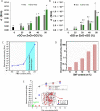Review of sustainable, eco-friendly, and conductive polymer nanocomposites for electronic and thermal applications: current status and future prospects
- PMID: 38372876
- PMCID: PMC10876511
- DOI: 10.1186/s11671-024-03965-2
Review of sustainable, eco-friendly, and conductive polymer nanocomposites for electronic and thermal applications: current status and future prospects
Abstract
Biodegradable polymer nanocomposites (BPNCs) are advanced materials that have gained significant attention over the past 20 years due to their advantages over conventional polymers. BPNCs are eco-friendly, cost-effective, contamination-resistant, and tailorable for specific applications. Nevertheless, their usage is limited due to their unsatisfactory physical and mechanical properties. To improve these properties, nanofillers are incorporated into natural polymer matrices, to enhance mechanical durability, biodegradability, electrical conductivity, dielectric, and thermal properties. Despite the significant advances in the development of BPNCs over the last decades, our understanding of their dielectric, thermal, and electrical conductivity is still far from complete. This review paper aims to provide comprehensive insights into the fundamental principles behind these properties, the main synthesis, and characterization methods, and their functionality and performance. Moreover, the role of nanofillers in strength, permeability, thermal stability, biodegradability, heat transport, and electrical conductivity is discussed. Additionally, the paper explores the applications, challenges, and opportunities of BPNCs for electronic devices, thermal management, and food packaging. Finally, this paper highlights the benefits of BPNCs as biodegradable and biodecomposable functional materials to replace traditional plastics. Finally, the contemporary industrial advances based on an overview of the main stakeholders and recently commercialized products are addressed.
Keywords: Electrical conductivity; Functional materials; Nanocomposites; Nanofillers; Thermal stability and conductivity.
© 2024. The Author(s).
Conflict of interest statement
Authors have no conflicts of interest associated with this publication to declare.
Figures









References
-
- Xu P, Liu X, Zhao Y, Lan D, Shin I. Study of graphdiyne biomimetic nanomaterials as fluorescent sensors of ciprofloxacin hydrochloride in water environment. Desalin Water Treat. 2023;302:29723. doi: 10.5004/dwt.2023.29723. - DOI
-
- Polymers for Advanced Techs - 2019 - Shojaie - Electrospun electroactive nanofibers of gelatin‐oligoaniline Poly vinyl.pdf, (n.d.)
-
- Zhang S. Auger scattering dynamic of photo-excited hot carriers in nano-graphite film. Appl Phys Lett. 2022 doi: 10.1063/5.0116720. - DOI
-
- Rostamian M, Hosseini H, Fakhri V, Yousefi P, Farahani M, Jalali A, Goodarzi V, Su C. Chemosphere Introducing a bio sorbent for removal of methylene blue dye based on flexible poly (glycerol sebacate)/chitosan/graphene oxide ecofriendly nanocomposites. Chemosphere. 2022;289:133219. doi: 10.1016/j.chemosphere.2021.133219. - DOI - PubMed
Publication types
LinkOut - more resources
Full Text Sources
Miscellaneous
